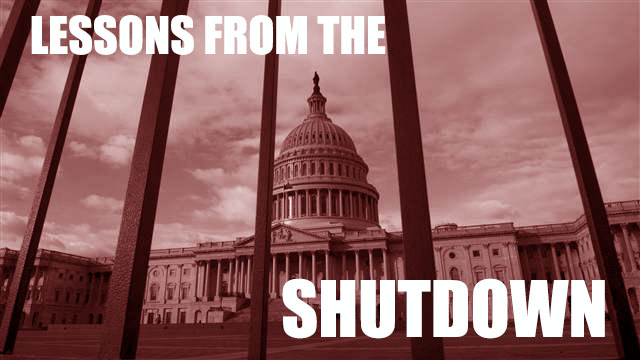The Lessons from the Shutdown Series examines the costs and consequences of the recent shutdown and debt ceiling fights. Philip Wallach, in an extension of his article at National Review, argues that there are more effective policy alternatives to the debt ceiling.
In my article over at National Review Online, I argue that the benefits of the debt ceiling are illusory and the costs are all too real, even if improbable. Debt ceiling brinkmanship serves all Americans badly, fiscal conservatives worst of all. So how should we proceed?
We should absolutely start by getting rid of the debt ceiling. The easiest ways of doing that would be to formally legislate either the Gephardt Rule or the McConnell Rule. The Gephardt rule was a 1979 innovation of the Missouri Congressman that helped minimize the impact of the debt ceiling until it was waived in 1995. It dictated that whenever the House passed its annual budget, the debt ceiling would be automatically deemed raised a corresponding amount. That makes sense, since it indicates a sensible recognition that deficit spending requires issuing more debt. In our current age of broken budgets, though, we would need to ensure that the rule would cover all continuing resolutions, too.
The McConnell Rule, devised by the Senate Minority Leader in 2011, is a sort of formal acknowledgement of the rhetorical character of the debt ceiling. It says that the President may raise the debt ceiling a certain amount unless Congress passes a joint resolution disapproving the raise, which the President would then have a chance to veto. Basically, all of the anti-debt speechifying would still go on, but the President would get to raise the limit unless two-thirds of both houses of Congress opposed him. Past versions of the McConnell Rule (2011 and 2013) are time-limited, but it would be simple to adopt it in perpetuity. That would pretty well neuter the debt ceiling, and would be an acceptable result. President Obama’s Treasury Department favors this course, and apparently Senator Schumer will soon propose legislation to this effect.
If fiscal conservatives want to install some new mechanisms designed to promote spending discipline, here are a few they could consider, drawn from my January Brookings White Paper, “Mr. Boehner, Tear Down This Ceiling”.
First, we could require legislative leaders and the President to provide formal explanations of distressing deficits. New Zealand’s Treasury Minister is required to provide such an explanation whenever debt deviates from “prudent” levels. We could require leaders from both parties to provide explanations—indeed, as long as we’re at it, why not make it a statutory requirement to offer the outlines of a plan that consists of something other than “wait for the voters to give my party complete control of government”? Such requirements are unlikely to have a huge impact, but they might improve deliberation about the debt.
Second, we could put automatic spending-control mechanisms into place that are directly sensitive to the business cycle. Automatic spending sequesters (ideally in combination with hard caps on tax expenditures) could kick in if unemployment is low and deficits are high—avoiding the pro-cyclical adjustments that Gramm-Rudman-Hollings caused. Since 2001, Switzerland has had such a “debt brake” that caps expenditures at revenues with business cycle adjustments. Such a rule might be passable, since it cannot be opposed on the grounds of being insensitive to our current jobs problem, and it would go a long way toward showing that America’s Keynesian budget instincts can be genuinely counter-cyclical instead of pushing us perpetually toward debt accumulation.
Far more fundamentally, we need to reform our dysfunctional budgeting process, so that serious consideration of debt accumulation takes place simultaneously with spending and taxation choices. A radical shift, which would expose the costs of our entitlement programs to much greater scrutiny than they currently receive, would be to move all government spending on-budget, thereby bringing all of the government’s liabilities into the budgeting process. This would potentially force hard choices about the tradeoffs between low-efficiency marginal health care spending and potentially high-return spending on research, basic infrastructure, etc. (It might also be quite destabilizing—so handle this recommendation with care.) Less radically, we should think carefully about what should follow when Congress fails to pass a new budget. Perhaps continuing resolutions should be forced to automatically push us toward balanced budgets, creating a default rule in which current unsustainable levels of spending are not retained simply through inertia and an inability of our two parties to compromise.
We could also try instituting a “No Budget, No Pay” law with teeth. The one that the largely-forgotten early-2013 debt ceiling compromise put into place ran into constitutional limits, so that it transformed into “No Budget, Late Pay.” But more importantly, it lets both chambers off the hook as long as they pass something, whether they even bother to bargain with the other body. That’s not very demanding. “No Budget compromise between the House and Senate, Late Pay” doesn’t have such a great ring to it, but it is worth a try.
Fiscal conservatives would do well to devote their energy to pursuing any of these ideas, which offer constructive and non-catastrophe-inducing ways of addressing the debt, rather than getting dragged into debt ceiling fights that force our country to flirt (however disingenuously) with default. There may well be other, better alternatives. But fiscal conservatives shouldn’t simply hold on to America’s peculiarly evolved debt ceiling because it is there. Doing so is unlikely to provide much leverage, and could very possibly end in disaster. If all we want is a chance for our legislators to take rhetorical stands against “too much debt,” sticking with the debt ceiling is a horribly irresponsible way to go.
The Brookings Institution is committed to quality, independence, and impact.
We are supported by a diverse array of funders. In line with our values and policies, each Brookings publication represents the sole views of its author(s).






Commentary
Lessons from the Shutdown: Alternatives to the Debt Ceiling
October 30, 2013